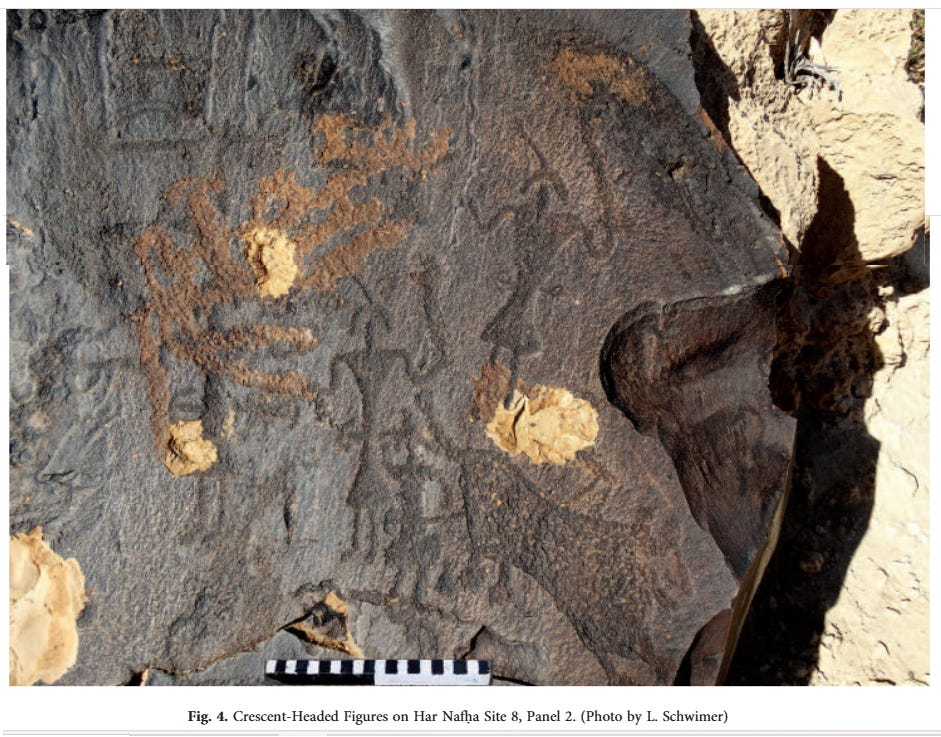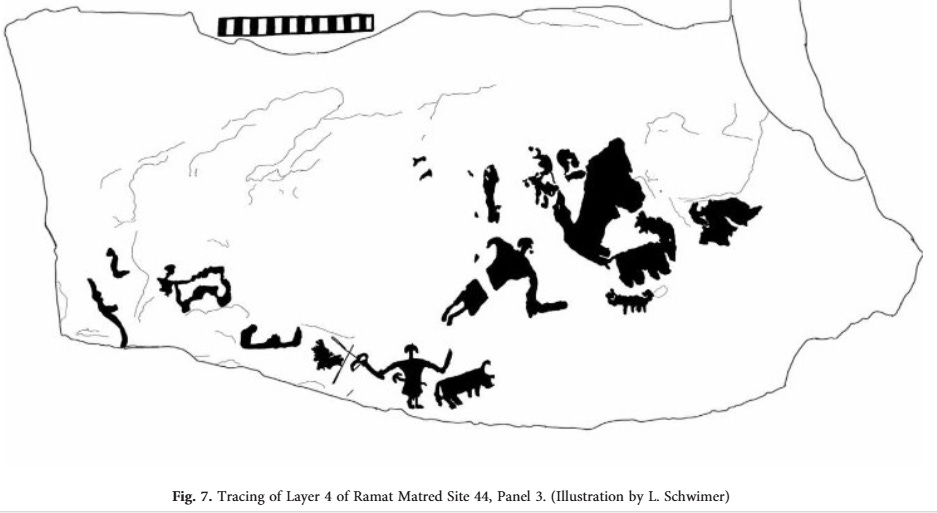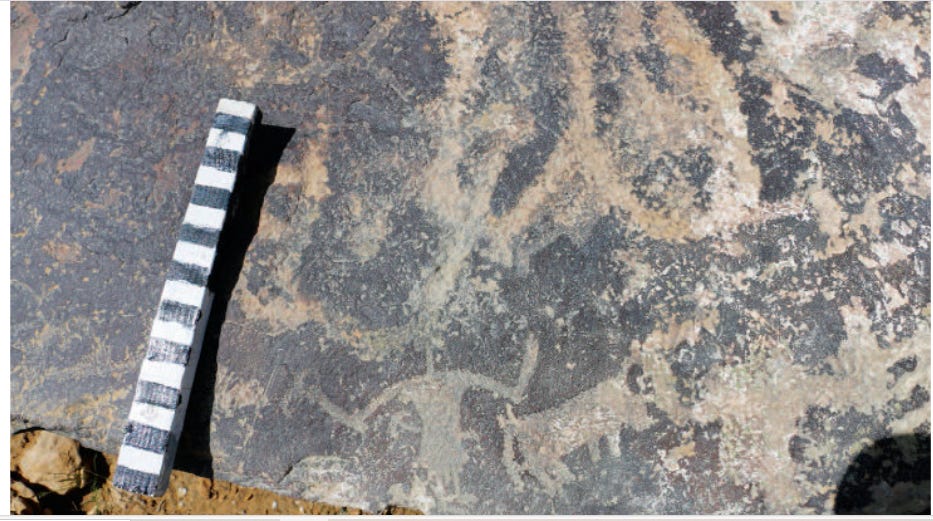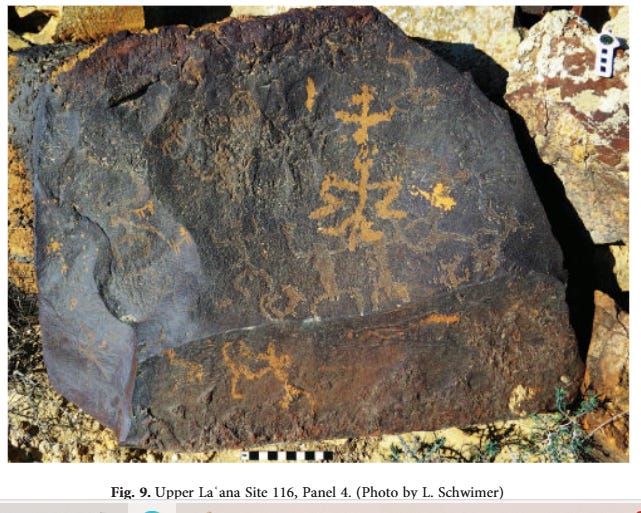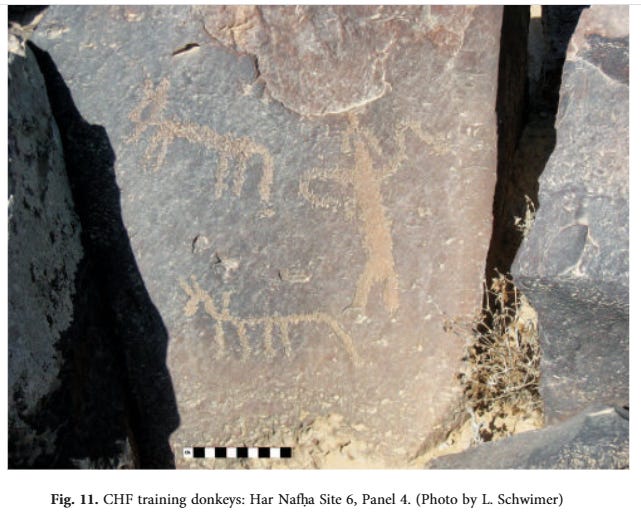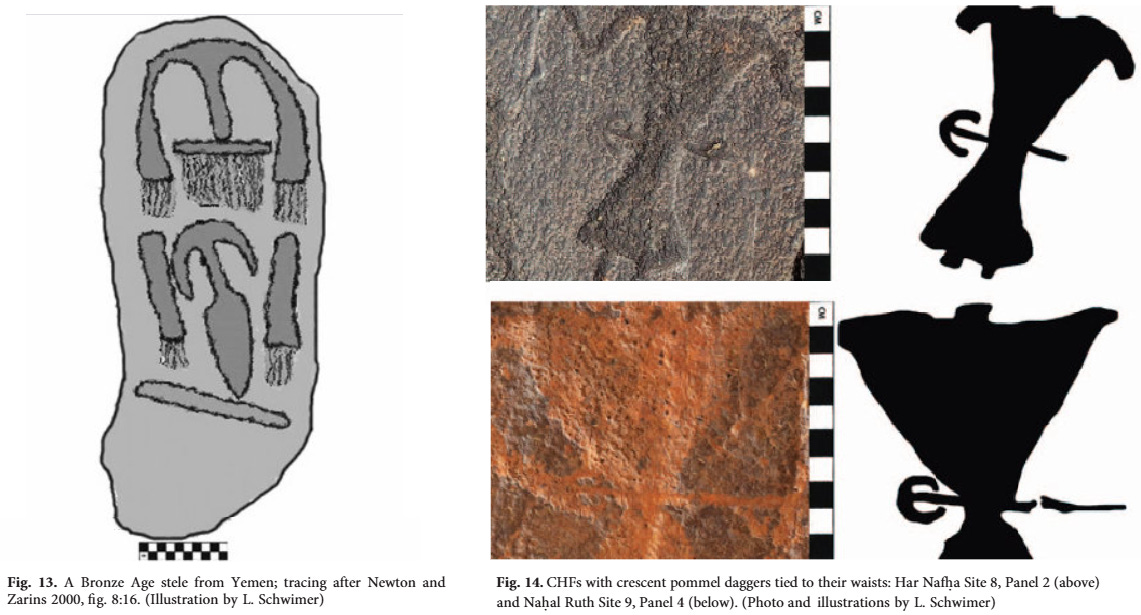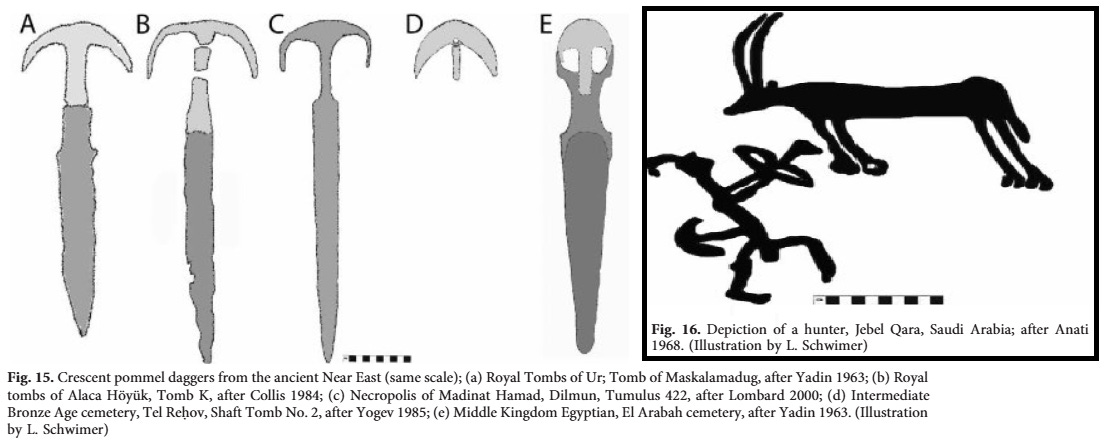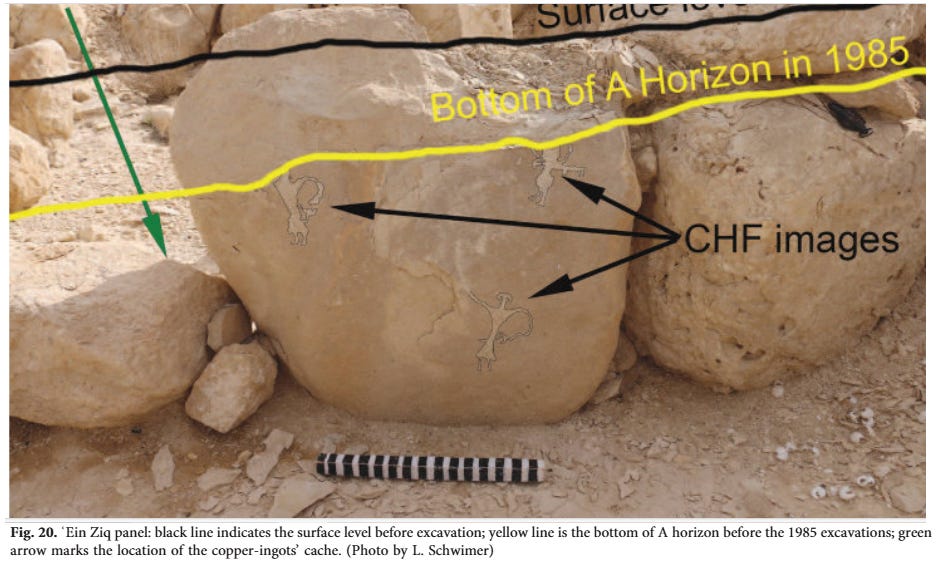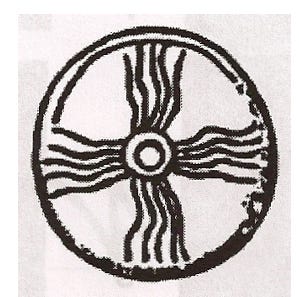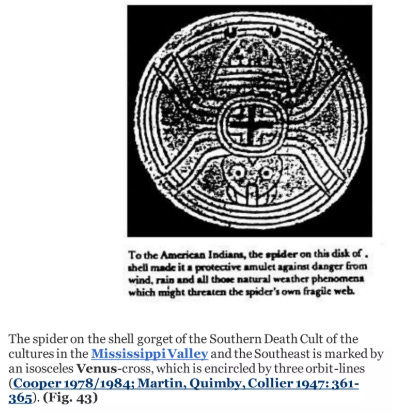THIRD EYE
I may compare these Third Eye papers with the Kronos Channel etc.
Third Eye = Aten = Shen
https://www.richardcassaro.com/
https://www.richardcassaro.com/third-eye-in-ancient-egypt/
https://www.richardcassaro.com/the-ancient-egyptian-third-eye/
https://www.richardcassaro.com/discovery-of-the-third-eye-in-the-ancient-americas/
BIRD-HEAD ROCK ART
I want to make a post of images from this video & maybe others, showing how rock art bird-head figures evolved to Egyptian gods. The ibis-headed Thoth in the video thumbnail resembles crescent-headed humanoid figures in rock art from the U.S. Southwest and Mexico that I saw possibly in an Academia.edu paper yesterday 4/16.
There is a well-established connection between ancient depictions of humanoid figures with bird heads—especially in Egyptian art—and deities like Horus, who is most famously shown as a man with a falcon's head1,4,6,7. In Egyptian mythology, Horus is the sky god, commonly depicted with the head of a falcon, symbolizing kingship, protection, and the divine link between the pharaoh and the gods1,6,7. Other Egyptian gods, such as Thoth (ibis-headed) and Bennu (heron or similar bird), also appear as bird-headed humanoids and play significant roles in Egyptian religious iconography2,3,7.
Comparison with Global Petroglyphs
Outside of Egypt, ancient petroglyphs and rock art in various cultures sometimes show humanoid figures with animal heads, including birds. However, the direct connection between these figures and Egyptian gods like Horus is not universally established in academic literature. Most interpretations focus on local mythologies or shamanistic symbolism rather than direct borrowing from Egypt. That said, some fringe researchers and comparative mythologists have speculated about ancient cross-cultural influences, especially where similar motifs (bird-headed beings) appear in distant regions, but these remain hypotheses rather than mainstream conclusions.
Egyptian Bird-Headed Deities and Symbolism
Horus: Depicted as a man with a falcon's head, symbolizing the sky, kingship, and protection. The falcon was sacred and closely associated with royalty and divinity in Egypt1,4,6,7.
Thoth: Shown with the head of an ibis, representing wisdom, writing, and the moon7.
Bennu: Sometimes depicted as a heron or similar bird, associated with creation, rebirth, and the sun2,5.
Bird Symbolism in Egyptian and Other Ancient Art
Birds were deeply symbolic in Egyptian culture, often representing the soul, the divine, and cosmic order3,7. The use of bird-headed figures in Egyptian art is distinctive and has influenced later iconography, but similar motifs in other regions are generally interpreted within their own cultural contexts unless there is clear evidence of contact or influence.
Summary Table: Bird-Headed Deities and Petroglyphs
Region; Example Figure; Description; Connection to Egypt?
Ancient Egypt; Horus; Falcon-headed man; Central deity, well-documented1,4,6,7
Ancient Egypt; Thoth; Ibis-headed man; God of wisdom, writing7
Ancient Egypt; Bennu; Heron or kingfisher-like bird; Symbol of rebirth, creation2,5
Global Petroglyphs; Bird-headed humanoids; Various, often shamanic or mythic; No direct, universally accepted connection
Conclusion
While ancient Egyptian religion is unique in its systematic depiction of bird-headed gods like Horus, and these images are iconic, there is no widely accepted direct link between Egyptian bird-headed deities and similar-looking petroglyphs in other parts of the world. Any connections proposed are speculative and not part of mainstream archaeological consensus. The Egyptian tradition of bird-headed gods is, however, among the most prominent and influential in the ancient world1,4,6,7.
2021 INTERMEDIATE BRONZE AGE CRESCENT-HEADED FIGURES IN THE NEGEV HIGHLANDS https://lenkinder.substack.com/publish/post/161157881
The main reason for Intermediate Bronze Age settlement in the Negev Highlands was related to the copper trade, but narrowed down the time frame for this activity to the first half of the Intermediate Bronze Age. … We now have a graphic notion of how some of the Intermediate Bronze Age community conceived of their appearance—as individuals with a distinctive headdress or headcovers—occasionally with a feather on top, wearing knee-high skirts, and consistently wearing a specific type of dagger attached to their belts. Also, they often carried small decurve bows. Their iconographic repertoire also includes references to animals that were not common to the region, such as lions and bulls, probably reflecting collective memories or myths. … We propose that the daggers were a part of the typical representation of people, probably men, in the southern Levantine Intermediate Bronze Age.
Depictions of Hawk-Headed Horus and Ibis-Headed Thoth: Time Periods
Time Periods of Hawk-Headed Horus and Ibis-Headed Thoth Depictions
Hawk-Headed Horus
Horus, often depicted as a falcon or a man with a falcon (hawk) head, was a major deity in ancient Egypt from the earliest periods. His worship and iconography are attested from the Predynastic Period (before 3100 BCE) and continued throughout Egyptian history, including the Old, Middle, and New Kingdoms, as well as the Ptolemaic Period3.
The specific image of Horus as a hawk-headed man was established early and persisted as a standard representation for millennia3.
Horus, depicted as a man with a falcon (hawk) head, appears in ancient Egyptian art as early as the Predynastic period (Naqada IIC, c. 3500 BCE)1.
This iconography continues through the Old Kingdom (e.g., Sixth Dynasty), Middle Kingdom, New Kingdom (e.g., reign of Amenhotep II, c. 1400 BCE), and persists into the Late Period and Ptolemaic Period (664–30 BCE)1,5.
Numerous statues, reliefs, and temple carvings from all these eras show Horus as a falcon-headed deity1,5,7.
Ibis-Headed Thoth
Thoth, the god of wisdom, writing, and the moon, was worshipped from the Pre-Dynastic Period (c. 6000–3150 BCE) and throughout all subsequent periods of Egyptian history, including the Ptolemaic era (ending in 30 BCE)4,8.
Thoth was commonly depicted as a man with the head of an ibis, and this iconography is found in art from the Old Kingdom onward, persisting through all later periods2,4,8.
Thoth is depicted as an ibis-headed man from at least the Old Kingdom, as the ibis symbol appears in the Pyramid Texts and on standards associated with Thoth8.
The oldest known depiction of Thoth in ibis-headed form may date to the reign of Khufu (Fourth Dynasty, c. 2600 BCE), though some early images lack explicit labels8.
Ibis-headed Thoth is well-attested in the New Kingdom (e.g., an ivory amulet from Dynasty 18, ca. 1539–1292 BCE)9, and this representation remains standard through the Late Period and Ptolemaic Period (664–30 BCE)6.
Were These Depictions Simultaneous or Consecutive?
The depictions of Horus as a hawk-headed man and Thoth as an ibis-headed man were simultaneous, not consecutive. Both forms are attested from the earliest periods of Egyptian civilization and continued in parallel throughout the history of ancient Egypt4,8. Their images appear together in temple reliefs, tombs, and papyri from all major periods, reflecting their ongoing and overlapping roles in Egyptian religious life.
Simultaneity or Sequence
The depictions of Horus as a hawk-headed man and Thoth as an ibis-headed man were simultaneous throughout ancient Egyptian history. Both iconographies are attested from at least the Old Kingdom and continue in parallel through the New Kingdom, Late Period, and Ptolemaic Period1,8,9. There is no evidence that one depiction replaced the other; rather, both were enduring and coexisting elements of Egyptian religious art.
THOTH
The Ship of Heaven
... , earthbound observers saw two revolving semicircles of light and shadow moving in a vast pathway around the stationary orb of Saturn. Hence, our model implies that the ship was part and parcel of the sun god's enclosure. In the Egyptian Pyramid Texts, King Unas announces, "I revolve round heaven like Ra, I sail round heaven like ____Thoth." (23) While Ra's image is the enclosed sun , the common symbol of ____Thoth is the crescent-enclosure . Allowing the one image to explain the other, we see that Unas does not here engage in two separate acts, but in a single act depicted in two different ways: to revolve within the Aten is to sail
The Opening of The Mouth Ritual - Part II
... Sem priest, acting as Horus, "touched [the mouth and eyes of the mummy] first with his little finger, and afterwards with a little bag filled with pieces of red stone or carnelian..." [167] Further evidence in support of this comes from the Book of the Dead. As Budge relates it, ____Thoth is said to have "brought back [the Eye of Horus] to the face of Ra [and] the filling of the utchat ____Thoth performed with his own fingers." [168] In this we see Mars, in the guise of ____Thoth, using his fingers to "fill" the ut-chat eye which, as we
The Hermes Connection
... B.C ., according to the historical reconstruction of Velikovsky. Seti's royal name was taken from the dark god Set, another Saturnian image or avatar, whom Wallis Budge claimed was equated with Hermes/Mercury, (12) although this identification stems from the late Ptolemaic period. Seti's formalized regnal association was with the comparable Egyptian deity ____Thoth (12a) , who is equated with Hermes. (13) Thus, Velikovsky's historiographic analysis is supported by this association. A comparison of a "dark god" with other ancient attributes pertaining to a bright effulgence presents a duality often encountered in myth. In Roman lore, for example, the Siva-like god of beginnings and endings
Egyptian Influence Upon Early Israelite Literature
... against you." [159] In similar fashion, Amenemope states: "Do not relocate the surveyor's stone to steal a field, nor move the surveyors line to take a farm. Do not covet another's land, nor poach on the widow's field. To forge a claim to the public path through a field, cries out to ____Thoth God of the Moon, for justice." [160] Proverbs warns the reader to observe a neighbor's boundary markers and not to encroach upon the land of people weaker than they. This warning comes with a reminder that God sees all and will bring justice on behalf of those who have been wronged. The "Instruction" sternly
The Hero's Garment
... the capital of a column in the temple of Dendera In the first place, the Mother Goddess is explicitly described as a garment. In the Pyramid Texts, the deceased king is made to proclaim: "My kilt which is on me is Hathor. I am girt with the girdle of Horus, I am clad with the garment of ____Thoth, Isis is before me and Nephtys is behind me." [13] We come across a near-identical situation in Geshtinanna's lament over the death of her brother Tammuz. "[ Geshtinanna] cried toward heaven, cried toward earth. (Her) cries covered the horizon completely like a cloth and were spread out like linen."
The Opening Of The Mouth Ritual - Part III
... and blood sacrifices between the Meso-americans and the Egyptians plus the "coincidences" involving mouth, heart, and eye. Hopefully, these will be of some interest as they go beyond the commonly held cultural similarities of pyramid build-ing, sun-gods, and a strong ritual trad-ition. In Egypt: Heart amulets of blue-green lapis-lazuli were recognized to belong to ____Thoth (a possible Mars god [14] ) and were substitutes for the deceased Osiris' heart. Heart-scarabs had Opening of the Mouth performed on them [15] and they in turn would "perform for him the ceremony of opening the mouth" [16] when put on, or in, the torso of the mummy,
The Evolution of the Cosmogonic Egg
... be seen mixed with breath during forceful human speech, so the "speaking" of the divine penis is accompanied by a powerful blast of wind, the holy, creative spirit, bearing the "spittle" of semen. This "spittle" is the visible "speech" of God... (49) In fact the Egyptian ____Thoth, whom the theologians of Hermopolis accepted as "the true universal Demiurge," was believed to have "accomplished the work of creation by the sound of his voice alone." It was he, according to this particular theology, who was responsible for the hatching of the world-egg. (50) But since, as we have
Astral Kingship
... a disintegration of that political stabilization and peace. (117) This purely sociological and earthbound interpretation of the Sed festival, on the part of Montet, falls flat, however. Furthermore, he may have misconstrued the significance of an Old Kingdom Egyptian text which referred to the divinities Horus, Set, Osiris Khenti-irty, Isis, Nephthys and ____Thoth as a single entity within the framework of the Sed festival. In one chapter of the Pyramid Texts, the same deities are invoked, reviled and most strongly urged to return to their place of origin and the king is forbidden to welcome them. (118) Montet found it "difficult to understand why [such popular gods]
Thanatos and Anastasis
... . 316-318). (46) Once the verdict in favor of Osiris was delivered- from that time forward the idea of truth was associated with [him] and he became the god of truth, and of those who spoke the truth. Moreover, Osiris, having been declared true of word, or true of voice, by ____Thoth, went up into heaven, and reigned there as king. He also became judge of the dead [and] had the power and the knowledge necessary for "weighing" [the words of men] when they should be tried at the last judgment. (47) Though Jesus was ultimately crucified, Pilate could find no fault
Sothis and the Morning Star in the Pyramid Texts
... Sothis as Venus is the logic behind the identifications of other celestial bodies mentioned in the Pyramid Texts, including S3h and Horus as the Morning Star. Indeed, we would suggest a thorough reevaluation of all astral identifications in the most ancient Egyptian texts, including such apparently obvious celestial bodies as those typically assigned to Ra (the Sun), ____Thoth (the Moon), and the circumpolar stars. Until now the study of the most ancient texts has been governed by a uniformitarian approach to the ancient cosmos; namely, the belief that the currently most prominent celestial bodies must have been uppermost in the ancients' minds as well. The latter belief is demonstrably erroneous. A new
Let There Be Darkness: An Archetypal Analysis of Adolf Hitler and the Third Reich
... Aesculapius) was the great god of healing in ancient Greece and was worshipped there for centuries. Yet, Asclepius "lacked an imagery of curing" which is one of the reasons why this healing god yielded to Christ and his shrines were abandoned. (59) The worship of healing gods (e .g . Apollo, Hermes, ____Thoth) and deified human beings (Imhotep-Asclepius, Amenhotep), who were also considered gods of healing, is historically traceable to the Greco-Roman world, ancient Egypt, and the Near East. (60) Likewise, the gesture of the saving right hand "can be traced through Hellenism back to the Ancient Orient. Right from primeval times
From Myth to a Physical Model
... the creator-king- the Demiurge (c .f ., the Greek Eros: in numerous sources one notes that the will or outflow of the creator's heart took form as the warrior hero). In the case of Egyptian symbolism the relationship can be confirmed in every major variant of the warrior hero, from Shu, to Horus, to ____Thoth. The heart from which the hero is born is the great goddess. Venus-Eye I believe it was O.G .S . Crawford who first drew scholars' attention to the widespread pictographs and symbolic images of what he called "the Eye Goddess." But the planet Venus he never mentioned, so he missed the key.
Morning Star*
... away from the encircling band, often visualized as an encircling wall, Horus was also lauded as "he who is south of [i .e ., below] the wall." (268) One last item I wish to mention, because we have to draw the line somewhere, is that in a somewhat late myth, ____Thoth decreed that Horus Behutet should thenceforth be called Light-giver. (269) I mention this because a near-identical name- Light Bringer or Light Bearer, that is Lucifer- was one of the Latin names for the Morning Star. THE DUAT When we saw Horus described as the god, or chief, of the Netherworld, the word translated
CRESCENT
Rock art in south Levantine dolmens https://www.academia.edu/92805771
The crescent headed figures reported from the Har Nafḥa and Ramat Matred desert rock art panels in the western Negev highlands are potentially illuminating: “The basic shapes of the ‘crescent headed figures’ are finely pecked human figures with an hourglass shaped body, crescent shaped head-cover, and a decoration at its tip. Daggers with crescent pommel handles are secured to their waists, and at times they seem to have additional garments” (Schwimer and Yekutieli 2017). Both the crescent heads and the crescent pommels of the dag- gers closely resemble the Shamir panel motif. Moreover, like the Shamir panel, the Negev crescent panels are dated to the IB based upon the following:
Main Themes in Rock Art by Millennium (5th–1st Millennium BC)
5th Millennium BC (5000–4000 BC)
Animals and Hunting:
Large wild animals such as buffalo, elephants, giraffes, and rhinoceroses were prominent, reflecting a hunter-gatherer lifestyle9,1,4.Early Pastoralism:
Cattle begin to appear, indicating the shift to herding and pastoralism, especially in North Africa and Egypt3,9,7.Human Figures:
Depictions of humans, often in hunting scenes or ritualistic postures, are common1,3,4.Community and Ritual:
In areas like the Latmos Mountains (Turkey), themes focus on human pairs and group rituals linked to fertility and weather gods5.Abstract and Geometric Motifs:
Floral, geometric, and labyrinthine symbols appear in some regions, possibly with ritual or symbolic meanings7.Environmental and Spiritual Connection:
Rock art sites were sometimes chosen for their acoustic properties, suggesting a mystical or multi-sensory experience1,2.
4th Millennium BC (4000–3000 BC)
Cattle Domination:
Cattle become the central motif, reflecting the rise of pastoral societies. Scenes include herding, milking, and cattle in pens7,9,3.Domestication and Agriculture:
Early evidence of ploughing, chariots, and agricultural activities emerges, especially in the Indian subcontinent and Valcamonica, Italy7,8.Ritual and Procession:
Depictions of ritual processions, such as the "great procession of the gods" in Egypt, indicate the increasing role of religious beliefs11.Boats and Navigation:
Early boat images appear, especially in Egypt, possibly linked to funerary beliefs3,11.Masked Dancers and Symbolic Scenes:
Human figures in ritualistic or masked forms are depicted, showing complex social and religious practices9.
3rd Millennium BC (3000–2000 BC)
Chariots and Horses:
The introduction of horses and chariots becomes a prominent theme, especially in the Sahara and Near East, reflecting new technologies and mobility9,8.Warfare and Weapons:
Scenes of conflict, warriors with spears and shields, and organized battles are depicted, particularly in Valcamonica and the Sahara8,9.Community and Social Life:
Group scenes, communal rituals, and depictions of daily life continue, with increasing complexity5,8.Religious and Mythological Motifs:
More explicit religious imagery, including gods, processions, and symbolic animals, emerges1,13.
2nd Millennium BC (2000–1000 BC)
Expansion of Horse Imagery:
Horses and chariots dominate, indicating their importance in trade, warfare, and elite society9,8.Agriculture and Settlement:
Continued themes of farming, ploughing, and settled life are evident in European and Asian rock art8,7.Magic and Symbolism:
Magical and ritual symbols, including abstract motifs, become more common, especially in Valcamonica8.Navigation and Travel:
Boats and travel scenes persist, reflecting increased mobility and trade networks3,8.
1st Millennium BC (1000–1 BC)
Camel Imagery and Writing:
The camel appears in Saharan rock art, marking adaptation to arid climates and the rise of trans-Saharan trade. Early inscriptions and writing also emerge9,1.Complex Social and Religious Scenes:
Scenes of processions, rituals, and mythological narratives become more elaborate, as seen in Egypt and the Near East1,13.Warfare, Weapons, and Elite Status:
Continued depiction of warriors, weapons, and chariots, often symbolizing power and status8,9.Contact and Change:
New motifs reflect contact with emerging civilizations and changing environments, such as the shift from horse to camel in the Sahara9.
Millennia in Which Peratt Plasma Apparitions Were Depicted in Rock Art
Anthony Peratt and colleagues have argued that distinctive plasma discharge formations—sometimes called "Peratt plasma apparitions"—are depicted in rock art worldwide. Their research links these motifs to high-energy auroral events visible in prehistory.
Dating of the Depictions
Radiocarbon Dating Evidence:
Peratt’s team references radiocarbon dating of material covering some petroglyphs, which places the creation of these plasma-related images between 4,000 and 12,000 years ago5. This range spans from the late Paleolithic through the Neolithic and into the Bronze Age.Millennial Breakdown:
5th Millennium BC (5000–4000 BC):
Plasma apparition motifs are included within this period, as petroglyphs dated to around 6,000 years ago (ca. 4000 BC) have been linked to these phenomena5.4th Millennium BC (4000–3000 BC):
Rock art from this era also contains plasma discharge forms, as the lower bound of the radiocarbon dates extends into this millennium5.Earlier Periods (up to 10,000 BC):
The upper end of the range (12,000 years ago) suggests some motifs may date to the late Upper Paleolithic, but the bulk of identified and dated examples fall within the 5th and 4th millennia BC5.
Evolution of Peratt's Plasma Apparitions in Rock Art (5th–1st Millennium BC)
Anthony Peratt’s hypothesis connects thousands of global petroglyphs to intense auroral plasma phenomena—specifically, high-current Z-pinch instabilities—visible in ancient skies. His comparative analysis of petroglyphs and laboratory plasma column behavior suggests a sequence of evolving visual forms, which ancient peoples recorded in stone1.
5th Millennium BC (5000–4000 BC)
Earliest Depictions:
The oldest plasma apparition motifs date to this period, coinciding with the end of the last Ice Age and the beginning of settled cultures.Forms: Predominantly simple, columnar shapes resembling the "axis mundi" or world tree, interpreted as towering pillars of light stretching from the horizon skyward.
Symbolism: These are often linked to the earliest myths of the cosmic pillar, tree of life, or ladder to heaven1.
4th Millennium BC (4000–3000 BC)
Increasing Complexity:
As the plasma event (according to Peratt’s model) evolved, so did the motifs.Forms: The columns develop "instabilities," producing hourglass shapes, "squatter man" figures (a humanoid with arms and legs splayed), and concentric rings or "eye" motifs.
Symbolism: These new forms are reflected in myths of gods with radiant bodies, eyes in the sky, and cosmic battles. The imagery becomes more anthropomorphic and dynamic1.
3rd Millennium BC (3000–2000 BC)
Peak Diversity:
Rock art from this era shows the widest variety of plasma forms, matching the most complex laboratory Z-pinch instabilities.Forms:
"Squatter man" and "stick man" figures with dots or radiating lines.
Nested rings, spirals, and "ladder" or "tree" motifs, sometimes with branching or bifurcating features.
"Hourglass" and "dumbbell" shapes, as well as "torus" and "double-dot" forms.
Symbolism: These are interpreted as mythic beings, world axes, or portals, and are often central to ritual contexts1.
2nd Millennium BC (2000–1000 BC)
Decline and Stylization:
As the hypothesized plasma events faded, motifs become more abstract or stylized.Forms:
Simplified versions of earlier plasma forms.
Continued use of "squatter man" and concentric ring motifs, but with less detail.
Symbolism: The imagery becomes more symbolic, incorporated into emerging religious iconography and mythic narratives1.
1st Millennium BC (1000–1 BC)
Residual and Mythologized Motifs:
By this period, direct plasma apparitions are rare; motifs persist mainly as inherited symbols.Forms:
Isolated "squatter man" or "axis mundi" forms appear in stylized religious or mythic contexts.
Some motifs are reinterpreted as deities, cosmic eyes, or ritual symbols.
Symbolism: The original plasma event is no longer witnessed, but its visual legacy survives in myth and art, often disconnected from its auroral origins1.
PERATT’S INTERPRETATIONS
Yes, Anthony Peratt’s rock art research does discuss bird-headed images and explicitly connects them, along with other unusual humanoid forms, to plasma discharge phenomena observed in high-energy laboratory experiments and simulations.
Key Points from Peratt’s Work:
Bird-Headed and Animal-Headed Figures: Peratt identified a wide variety of recurring motifs in global rock art, including figures that resemble humans with bird or animal heads. These are among the many shapes he cataloged as matching the forms created during intense plasma discharge events, particularly those known as “z-pinch” instabilities4,6.
Plasma Apparitions: Peratt and collaborators argue that these recurring motifs—including bird-headed figures, “squatter men,” “stick men,” and other abstract forms—are not random or purely symbolic. Instead, they are argued to be direct visual records of plasma formations visible in the ancient sky during episodes of extreme auroral activity, possibly triggered by geomagnetic disturbances or cosmic events4,6,8.
Specific References: In his 2003 and later papers, Peratt details how “ladders,” “caterpillars,” “birds on sticks,” “squattermen,” and other forms—including bird-headed figures—correspond to specific phases and instabilities in laboratory plasma columns. These shapes, he argues, are consistent across continents and cultures, suggesting a shared, real visual phenomenon rather than isolated cultural invention4,6.
Interpretation: While Peratt does not directly equate these bird-headed figures with mythological gods like Horus, he does suggest that the widespread appearance of such forms in ancient art reflects a universal experience of witnessing plasma apparitions in the sky, rather than independent, culture-specific mythmaking4,6,8.
Summary Table: Peratt’s Approach to Bird-Headed Figures in Rock Art
Aspect; Peratt’s Position
Bird-headed figures; Common in global rock art, match plasma forms
Plasma connection; Shapes reflect plasma instabilities (z-pinch, etc.)
Mythological link; Not directly to gods, but to witnessed phenomena
Geographic distribution; Worldwide, supporting a shared visual experience
In conclusion, Peratt’s research does discuss bird-headed images in rock art and interprets them as representations of plasma discharge phenomena witnessed in the ancient sky, rather than as purely mythological or symbolic figures4,6,8.
………………………………..
OTHER ANIMAL HEADS IN MYTHS
Anzu bird, a lion-headed eagle,
Lamassu (e.g., bulls or lions)
Ganesha, the elephant-headed
Hanuman, the monkey god
lion-headed
dog's head1.
……………………………………………….
ANIMAL HEADS IN ROCK ART
spiritual or narrative contexts2,4,6
………………………………………………………
CROSS
The Great Star - maverick science.com
“The planet Venus is associated with the color red among the Maya of Mexico, for its name is given, even in Maya dictionaries from early Colonial times, as ‘red/great star’. The same association holds for the Maya of Classical Times (300-900 AD) and of the Post-Classic period (900-1400 AD). We know this because the Classic and Post-Classic Maya had a glyphic writing system, and in it the glyph collocation representing Venus includes the glyph for the color red. More specifically, the Lamat-Venus glyph (T510) is the glyph of the planet Venus, an identification accepted by virtually every epigrapher concerned with Maya glyphs. The basic form of the glyph—a circled cross with a circlet in each quadrant—is so widespread that it has the meaning ‘Morning Star’ (which we usually interpret as Venus) among the Tarahumara of Northern Mexico. The name that some Mayans have for Venus appears to have been borrowed by Tarascans (as far away as Michoacan, Mexico).
The Drilling of Fire and the Origin of the Sun
Xiuhtecuhtli’s inherent connection with the four directions is also attested by his association with the so-called quincross, one of the most common symbols in Mesoamerican culture (see figure nine, wherein the god’s headgear displays a number of quincrosses).104 Typically painted a luminous turquoise color, the cross in question is widely believed to symbolize or represent the Morning Star.105
105 J. Langley, “Teotihuacan Notation in a Mesoamerican Context,” in M. Gallut ed., Ideología y política a través de materiales, imágenes y símbolos (Cordoba, 2002), p. 286: “These suggest that both the Quincross and its five circlet counterpart, the Quincunx, may on some occasions signify the planet Venus.”
Much like the quincross, the quincunx was closely related to the color turquoise: “For the Aztecs, the quincunx represented turquoise, xiuitl, an important morpheme in the name Xiuhtecuhtli.”108 At the same time the symbol is also thought to represent an Olmec symbol of the Morning Star.109
In addition to presenting a cross-like form, the “Great Star” image features a dark “sun” at the center of a four-fold star whose “rays” radiate outwards.113
Figure 12
With regards to the cruciform appearance of the “Great Star,” quincross, and Lamat sign, it is significant to note that Amerindian tribes across the North American continent represented the Morning Star as a cruciform object. Such was the case amongst the Blackfoot114, Arapaho115, and Kiowa116, among others.117 Of the images in question, Alice Kehoe reports that the Maltese cross representing the Morning Star was typically painted green in color.118 Similar conceptions are evident in Mesoamerica, where Quetzalcoatl was represented bearing a shield with a Maltese cross.119 According to Kehoe, the Maltese cross had reference to the four directions: “Maltese crosses also occur prehistorically in Mesoamerica, where in the Valley of Mexico the basically similar four-petal flower design symbolized the universe (the four directions with the world in the center).”120 The Navaho, like the Aztecs, were keen observers of the sky and stellar imagery are conspicuous in their sacred iconography and artworks.121 For the Navaho the stellar cross represented fire: “The cross also represents other things including fire and the four directions.”122 Now here is an idea not readily explained by the present sky: Why would fire, of all things, be compared to a cross or related to the four directions?123
123 Fire was represented as a cross in Old Europe as well. See V. Straizys & L. Klimka, “The Cosmology of the Balts,” Journal of the History of Astronomy 22 (1997), p. 66.
Although it is evident that the four streamers presented a plethora of different structural forms during the polar configuration’s evolutionary history, the most spectacular phase—that associated with the very moment of Creation— found them assuming a brilliant turquoise color. Hence the turquoise color of the quincross associated with Xiuhtecuhtli. Make no mistake about it: The turquoise cross radiating outwards from the Aztec fire-god constitutes a cosmogram encoding a historical reality—specifically, the prototypical appearance of the Morning Star/Sun.
On Thundergods and Thunderbolts
Figure 5
The pictograph in figure five presents a cross-like form set in the center of the so-called “sun.” Significantly, a cross was also associated with the thundergod in ancient Europe. This was the case with the Norse Thor, for example: “An equal-armed cross was already in use as a symbol in the heathen period, and seems to have been associated with Thor.”52
Similar conceptions surround the Vedic thundergod. Thus, Indra’s thunderbolt was described as “four-edged”: “Bull, hurler of the four-edged rain producer.”53 We will return to the four-fold form of the thunderbolt below. In addition to being likened to a cross, Thor’s thunderbolt was elsewhere represented with a swastika-like form on ancient monuments.54 Davidson offered the following thoughts on this aspect of the thunderbolt’s iconography: “Primarily it [swastika] appears to have had connection with light and fire, and to have been linked with the sun-wheel. It may have been on account of Thor’s association with the lightning that this sign was used as an alternative to the hammer, for it is found on memorial stones in Scandinavia beside inscriptions to Thor.”55
If the imagery of the swastika originated in spectacular events associated with the polar configuration, it stands to reason that the symbol would be associated both with the thundergod himself and with the ancient sun-god. That this is indeed the case is obvious from what has already been cited. It also stands to reason that the swastika would be intimately related to the various mythical interpretations of the wavy forms emanating from the central orb; i.e., streams of water, wind, pillars, hair, arrows, etc. Thus, it is most significant to find that the Maya knew the swastika as the “cross of four winds.”59 A survey of the relevant literature would doubtless find similar associations between the swastika and the other mythical interpretations of the Venusian outflow.
“In Lithuania, the axe as a life-stimulating symbol, is laid under the bed of a woman in labor; on the sill to be crossed by the newly-wedded couple…During sowing, axes were thrown onto the field.”113
Let us begin, therefore, with the most common ancient symbols of the divine thunderbolt. All of the unusual motifs listed below find wide distribution in the ancient world--
https://www.slideshare.net/slideshow/the-birth-of-venus-out-of-orion/55859311
CROSS < AEON
The Saturn Thesis (Part 2)
... (As I suggested above, the tri-form appears to be the unique form of Venus prior to departure from its position squarely in the center of Saturn.) But for now I think we should stop here, since other features of the evolving configuration are just as interesting and will give us the bigger picture we are looking for. EQUAL-LIMBED ____CROSS AEON: Without getting away from the bigger picture you refer to, can you at least tell us something concerning the relationship between the tri-form and the four-armed ____cross? Talbott: Though the configuration of the life-streams was not static, and there is more than one archetypal form of the Radiant Venus, the four-armed ____cross is certainly a Venus
The Ship of Heaven
... From a number of indications it can be assumed that the band visually enclosing the orb of Saturn possessed a fluid appearance, giving rise to the idea of an encircling river or ocean. To an observer on Earth the real sense of revolution was provided not by the band per se, but by the crescent and the arms of the sun ____cross- both appearing to revolve around Saturn as the Earth turned on its axis. To those who viewed this spectacular daily cycle, it appeared as if the great ship sailed daily around an immense, fiery river or ocean. It is, to say the least, unlikely that anyone looking out at our rising and setting Sun would wish ...
The Garden of Venus
... four streams belong to the primeval enclosure." [39] In a more recent study of this symbolism, Talbott offered the following conclusion with specific reference to the Shamash-sign shown in figure three: "The image seems to suggest four rivers streaming from the nave or hub of the wheel in four directions." [40] The Venus ____Cross Figure 4 We have suggested that traditions of a sacred spring associated with Venus trace to the quaternary symbolism associated with the ancient sun-god. But why should this be the case? Why would Venus-symbolism trace to the sun? As I have documented, there are compelling reasons for believing that the planet Venus once appeared set in the center of
Maya Cosmos: A Saturnian Interpretation
... , called Seven-Macaw in the Popol Vuh. And finally, in some tales, Itzamna is related to, or is actually renamed as, the Maize God of the fourth creation. But I am getting ahead of myself, so here is a brief summary of the these last creations. Na-Te' K'an "First-Tree-Precious" also known as the Foliated ____Cross. (NOTE: The large base of the ____cross is the deified offering plate of sacrifice, the Quadripartite God.) The Cosmic Hearth "First" or "Green Three-Stone Place" Wakah-Chan: The World Tree The creator gods (a decorated Maya pot exists that shows seven gods of creation) get together in the blackness and decide
Paired Sets in the Hebrew Alphabet
... ' or clew' (for instance, of wool or cotton)." (46) Moran gives it a meaning of "mud," "mire," "potter's clay'," derived from Hebrew tit , "loam," "clay," "mud." The Early Hebrew form of the letter, a ____cross within a circle, is a Western astrological symbol referring to the planet Earth. The notion of "coiling, twisting" can easily be related to twisting or coiling thread on a spindle to create a ball of cotton or wool, and it is clear that the spindle can symbolize the earth, world, or universe (47)
RECONSTRUCTING THE SATURN MYTH
... Aten is itself the "mistress" of the sun god, and the evidence in its totality will leave no doubt that the universal goddess and the band of the enclosed sun mean the same thing, with each of the "incongruous" attributes of the goddess finding its explanation in an explicit attribute of the band. (25) Sun ____Cross It was an ancient practice of the Egyptian king, on assuming the throne, to release an arrow in each of the four directions, an act which served symbolically both to affirm the divine stature of the king and to consecrate the land as a terrestrial copy of the "ideal" land organized by the central sun in the sky
The Cosmic Double Helix
... not make much of a difference in the final analysis, I will keep the categories formally apart, beginning with the representations where the central rod is missing. Medieval European tradition is brimming with images of intertwining serpents. The symbol of the entwined worms or serpents was common in Gnosticism. [3 ] A decoration in the 10th century High ____Cross Monasterboice from County Louth, Ireland, shows a hand placed within a set of concentric rings surmounting two intertwining dragons making three loops between which are placed three heads. [4 ] As in the case of the Sumerian cylinder seals, the number of loops amounts once more to three and the depiction of three heads within these loops forges
Thundergods and Thunderbolts
... and from the joints of his flint armor flash the four lightnings, hurling his enemies down into the earth." [56] Among the god's enemies is included a giant monster which threatened to destroy the world. The pictograph in Figure 8 presents a ____cross-like form set in the center of the so-called "sun." Significantly, a ____cross was also associated with the thundergod in ancient Europe. This was the case with the Norse Thor, for example: "An equal-armed ____cross was already in use as a symbol in the heathen period, and seems to have been associated with Thor." [57] Similar conceptions surround the Vedic thundergod. Thus, Indra's thunderbolt was
On testing The Polar configuration
... the cardinal points." (134) [With the polar configuration as a reference, the concept of a central spring or river whose waters are dispersed in the four directions acquires special significance. In the polar column it is easy to imagine a central water source welling up from below to distribute its contents through the arms of the sun ____cross above. It would not be unreasonable, in other words, to look for similar ideas elsewhere.] The Chinese paradise of Kwen-lun, adorned with pearls, jade, and precious stones, lay at the center and zenith of the world. In this happy abode stood a central fountain from which flowed "in opposite directions the four
The Saturn Thesis
... to treat the celestial contexts of patterns (1 ) and (2 ) as the same. streams arranged symmetrically in straight lines. This motif actually embodies several recurring forms- raising some fundamental issues of dynamics. Repeated patterns around the world indicate a particular concentration of three, four, and five "spokes" radiating outward. The equal-limbed ____cross is perhaps the most common pictographically, but the five-pointed "star" of Venus occurs with great frequency as well. Is it possible that the preference for symmetry has distorted an original appearance that was not so neatly and "improbably" symmetrical? To answer this question one must take into account many layers of evidence beyond the pictographic.
Let There be Darkness: The Reign of the Swastika by Lewis M. Greenberg
... century, also used the swastika in his publications. As Greenberg notes, Hitler recognized the swastika's psychological magic as a symbol which was as powerful as, but distinct from, both the Communist hammer and sickle and the crescent of Islam. Later, with the armies of the Third Reich, the swastika "came dangerously close to supplanting the ____cross of Christianity." The Nazi Party turned into an organization which was full of icons, but the swastika remained its supreme symbol, the one with mesmerizing power over the masses. It was, as Greenberg notes, the "simulacrum of the living god- Adolf Hitler- and the two were interchangeable." Anyone who has seen
The Rise of Blood Sacrifice
... This is where the above mentioned universal human propensity to seek reconciliation with the deceased enters the Bronze Age rituals. Worship of ancestors and worship of victims stood on common ground. For the purpose of reconciliation, the corpses- or parts of them- were elevated. This was often done by fettering or chaining them to pillars, posts, ____crosses, etc. Those asking forgiveness in front of the raised victims turned themselves into worshippers of idols representing cosmic powers. Simultaneously, they also sanctified the supports to which the corpses were fixed. The supports formed a constant element of the holy precinct whereas the carcasses sooner or later had to be removed to make room for fresh victims.
SERVANT OF THE SUN GOD
... . The Mars-column. It is the specificity of the polar column and its relationship to other forms of the polar configuration that gives the testing of the thesis a straightforward agenda. Not only the warrior-hero's identity with the column in all of its mythical forms, but the required relationships to central sun, enclosure and crescent, arms of the sun ____cross, and spiralling cometary curl afford a nearly endless opportunity to apply the theory and to challenge it wherever the predicted relationships are not confirmed. What must be clear to anyone reviewing the complex of warrior-hero themes is the extraordinary preponderance of images suggesting a visible column below the domain of the gods (the ancestral "homeland" of the myths
The Cosmic Origin of the Swastika
... , at times, these gases appeared in more complex forms) that would eventually have given rise to an ogee-like manifestation, that is a curved swastika. Sagan and Druyan themselves have reasoned that the swastika in a comet's head is derived from four "symmetrically placed jets" which, in a non-rotating cometary nucleus, would look like a four-armed ____cross. And it is the rotation of the comet's nucleus that turns this ____cross-like stream of jets into a curved-armed swastika. (32) The description of the method by which a stationary ____cross turns into a rotating swastika would be just as valid for turning the four-armed ____cross-like stream of gases in the Saturnian configuration into a rotating ogee. But
Thanatos and Anastasis
... himself, who encourages the seekers, Isis, Nephthys and their attendant crowd of priests and worshippers, to get to the end of the mystery, to complete his liberation, and join in the acclamation that "Osiris is found." The above commentary finds its dramatic counterpart in the death and resurrection of Jesus who was crucified upon a ____cross of wood (a slight reversal of coffin to tree theme) and then extricated therefrom; was interred within a hewn rock whose mouth was covered by a huge stone (a variant of Osiris' coffin and its stone lid); arose from the dead and left his sepulcher after the stone was "rolled away" to be revealed
On Models and Scenarios
... a year and a half-ago, I challenged others to see if they could come up with any planetary or other celestial arrangement (no matter how preposterous, and without concern for physics) (8 ) that would present to terrestrial man the three most common images in the ancient world- the enclosed sun , the sun-in-crescent , and the sun ____cross . I've yet to receive an answer from anyone: only something very much like the polar configuration, with planets in polar alignment, will yield the required images. It can also be seen that the relative sizes of the planets must cooperate in the model in order to allow for the stated celestial forms and relationships. It happens that
Return to the Paelo-Saturnian Ssystem (Forum)
... by Talbott, Wallace Thornhill has interpreted this as a plasma discharge ejected by the newly born planet Venus. [82] It was the appearance of these streamers which ancient man interpreted inter alia as the hair of the goddess. And, yes, at one time, these radiating streamers did bunch up and take on the form of a ____cross, represented in myth inter alia as a quadrifurcate river. I have never, however, described this quadriform as "arms." Nor have I ever stated anywhere that Venus' cometary tail "descends to Earth." As for Bar-Ron's comments concerning the cover of AEON VI:1 , which exhibits the exquisite painting by Talitha Acheson
Let There Be Darkness: An Archetypal Analysis of Adolf Hitler and the Third Reich
... . (138) And, from a purely personal standpoint, Hitler "wanted to be seen as a heroic figure straight out of German history books". (139) By the 1930s his wish was granted. Paintings by H. Lanzinger and K. Stauber portray Hitler as either a Medieval knight, "the bearer of a new ____cross (the swastika) and the defender of racially pure Germania", (140) or Germanic Messiah. (141) In Lanzinger's portrayal, he becomes a 20th century Lohengrin (142) or Parsifal; in Stauber's Germany Lives, it is as though Piero della Francesca's Resurrection and Eugene Delacroix's Liberty Leading the People have been melded to
THUNDERBOLTS IN ANATOLIA
Ancient rock art that likely depicted thunderbolts can be identified by certain abstract motifs and symbols interpreted as representations of lightning, often in connection with thunder gods or supernatural phenomena.
Common Motifs Depicting Thunderbolts
Barbed Signs and Forked Motifs: In European Paleolithic cave art, particularly in sites like Lascaux, abstract barbed or forked signs have been interpreted as possible depictions of lightning or thunderbolts. These motifs resemble tridents or branching lines, which are reminiscent of the stylized thunderbolts associated with thunder gods in later mythologies2.
Spears, Arrows, and Tridents: Many ancient cultures symbolized lightning as spears, arrows, or tridents thrown by deities. Some cave art includes such shapes, which may have served as early visual metaphors for thunderbolts, especially when found alongside images of hoofed animals (often linked to thunder spirits in myth)2,1.
Native American Rock Art: In North America, zigzag lines and forked shapes in petroglyphs are commonly interpreted as symbols for lightning. These motifs are often associated with thunderbirds or other supernatural beings believed to control storms and lightning3.
Mesoamerican and Australian Examples: In Mesoamerica, wide-eyed figures like Tlaloc (rain/thunder god) appear in rock art at echoing sites, while in Australia, the Lightning Brothers are depicted in Aboriginal rock art, sometimes with motifs that may represent lightning2.
Interpretive Context
Many of these motifs are found in caves or rock shelters known for their acoustical properties, such as strong reverberation, which ancient peoples may have associated with the sound of thunder. The combination of animal imagery (especially stampeding ungulates) and abstract signs in these settings suggests a symbolic link between the visual motifs and the phenomena of thunderstorms and lightning2.
The abstract nature of these signs means their interpretation relies heavily on ethnographic analogy and mythological context, but the recurring presence of barbed, zigzag, or forked motifs in association with thunder myths across cultures supports the idea that these were intended as thunderbolt or lightning symbols2,3.
THUNDERBOLTS OF THE GODS
https://archive.org/stream/Thunderbolts_201902/Talbott-Thunderbolts-of-the-Gods_djvu.txt
Main Motifs in Thunderbolts of the Gods
Thunderbolts of the Gods identifies and explores a series of recurring motifs found in ancient mythologies, symbols, and art. These motifs are interpreted as records of extraordinary plasma and electrical events witnessed in the ancient sky. Here are the main motifs discussed in detail:
1. The Cosmic Thunderbolt
Description: The thunderbolt or lightning bolt is a central motif, often depicted as a weapon of the gods or a force of cosmic destruction and renewal.
Mythological Role: Thunderbolts are wielded by sky gods such as Zeus, Indra, Thor, and others. They symbolize divine power, retribution, and the ability to shape or destroy worlds5.
Interpretation: The book argues these motifs are stylized memories of plasma discharges-immense electrical phenomena observed in the ancient sky, not just poetic metaphors1,4.
2. Serpents, Dragons, and Chaos Monsters
Description: Serpentine and dragon-like creatures are pervasive in world mythology, often associated with chaos, destruction, and cosmic battles.
Attributes: These creatures are described as fiery, shape-shifting, with long-flowing “hair” or “feathers,” and as bringing darkness or chaos4.
Plasma Connection: The authors link these motifs to the visual forms of high-energy plasma discharges, which can appear as writhing, luminous filaments or serpentine shapes in plasma physics experiments and, they argue, in the ancient sky1,4.
3. The Golden Age and Doomsday
Description: Myths universally recall a lost “Golden Age” of peace and abundance, followed by a catastrophic end-Doomsday.
Dual Motif: The yearning for a return to paradise and the fear of another cosmic catastrophe are inseparable in ancient traditions4.
Interpretation: The transition from Golden Age to Doomsday is seen as a memory of dramatic changes in the plasma environment of the Earth, as witnessed by ancient peoples4.
4. Arcs, Threads, and Filaments
Description: Visual motifs such as arcs, threads, and filaments appear in both ancient art and modern radio images of the galaxy.
Plasma Discharge Forms: These forms are typical of electrical discharge in plasma and are interpreted as direct visual memories of cosmic electrical events1.
Symbolism: Such motifs are found in ancient carvings, petroglyphs, and religious iconography, often abstracted into stylized patterns or “thunderbolts”1.
5. Shape-Shifting Gods and Monsters
Description: Many archaic deities and monsters are described as shape-shifters, changing form in the midst of cosmic battles.
Plasma Explanation: The book suggests this reflects the changing configurations of plasma discharges, which can morph rapidly and dramatically, matching the “metamorphosis” described in myth4.
6. Rivers of Fire and Luminous Clouds
Description: Ancient accounts often mention rivers of fire, luminous clouds, and undulating lights filling the sky during mythic events.
Interpretation: These are seen as descriptions of large-scale auroral or plasma phenomena, not mere allegory or poetic invention1.
Summary Table of Motifs and Their Interpretations
MotifMythological ExamplePlasma/Electric Universe InterpretationThunderboltZeus, Thor, IndraPlasma discharge, cosmic lightningSerpent/Dragon/Chaos MonsterTiamat, Leviathan, Chinese dragonFilamentary plasma, writhing current structuresGolden Age/DoomsdayParadise Lost, RagnarokShifts in plasma environment, catastrophic eventsArcs, Threads, FilamentsPetroglyphs, galactic imagesElectrical discharge patterns in plasmaShape-shifting DeitiesProteus, Loki, QuetzalcoatlMorphing plasma formationsRivers of Fire/Luminous CloudsBiblical Exodus, Norse mythsAuroral/plasma phenomena
These motifs are central to the thesis of Thunderbolts of the Gods: that ancient peoples witnessed and mythologized awe-inspiring plasma and electrical events in the sky, encoding their experiences in the universal symbols and stories of world mythology1,4.




